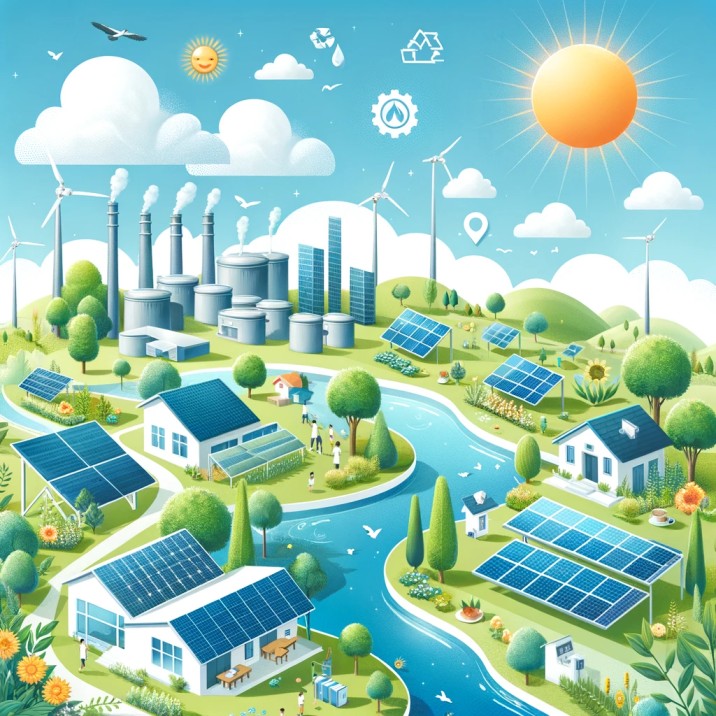Solar light energy is the energy from the sun that can be converted into electricity or heat. It is harnessed using technologies like solar panels, making it a renewable and sustainable source of power for various applications.
Solar light energy refers to the harnessing of the sun’s energy and converting it into electricity for practical use. This sustainable resource is becoming increasingly vital in the global pursuit of renewable energy solutions.
The Science Behind Solar Energy

Solar energy is fundamentally the energy provided by the sun. This energy is created through nuclear fusion that takes place in the sun’s core. During this process, hydrogen atoms fuse to form helium, releasing a tremendous amount of energy in the form of photons. These photons travel through space and reach Earth, providing us with sunlight.
Solar radiation, encompassing a range of frequencies of electromagnetic energy including visible light, ultraviolet light, and infrared rays, travels approximately 93 million miles from the sun to the Earth. The intensity of this solar radiation is significant as it is the primary natural source of energy for all surface phenomena and life forms.
The most common method of harnessing solar energy is through photovoltaic (PV) cells, commonly known as solar cells. When photons strike a PV cell, they may be reflected, absorbed, or pass through. The absorbed photons generate electricity through the photovoltaic effect. This effect occurs when photons dislodge electrons from atoms in the semiconductor material (typically silicon) of the solar cell, creating a flow of electricity.
A solar cell is made of semiconductor materials, which have properties between conductors and insulators. Silicon is the most widely used semiconductor in solar cells, known for its abundance and photovoltaic efficiency. A solar cell has two layers: the n-type (negative) layer, which has extra electrons, and the p-type (positive) layer, which has extra spaces for electrons, known as holes. The junction between these two layers creates an electric field.
When light energy causes electrons to move, they naturally migrate to the n-type layer. This movement generates a current as electrons move toward the p-type layer to fill the holes. The electric field at the junction prevents the flow of electrons back to the n-type layer, thereby creating a directional current.
Solar panels consist of many individual solar cells connected together. When these panels are exposed to sunlight, they generate direct current (DC) electricity. However, most homes and businesses use alternating current (AC) electricity. Therefore, an inverter is used to convert DC electricity from the solar panels into AC electricity.
The efficiency of solar panels, currently around 15-20%, is a measure of their ability to convert sunlight into electricity. Research in materials science and engineering is continually advancing the efficiency of solar cells, exploring new materials like perovskites, and developing techniques like stacking cells in multi-junction solar panels.
In addition to photovoltaics, solar energy can also be harnessed as thermal energy. Solar thermal technologies use sunlight to heat water or air for residential and industrial use. Concentrated solar power (CSP) plants utilize mirrors to focus sunlight to heat a fluid, which is used to generate steam and drive a turbine to produce electricity.
Types of Solar Energy Systems

Solar energy systems are broadly categorized into two main types: Photovoltaic (PV) systems and Solar Thermal systems. Each type utilizes the sun’s energy in different ways and for various applications, catering to diverse energy needs.
Photovoltaic (PV) systems are the most common and widely recognized form of solar energy technology. These systems use solar panels, comprised of many solar cells, to convert sunlight directly into electricity. The fundamental principle behind PV systems is the photovoltaic effect, where sunlight hitting the solar cells generates electric current. PV systems can range from small-scale systems like those used in calculators and residential rooftops, to large-scale solar farms that feed electricity into the grid. They are versatile, scalable, and can be integrated into various settings, including buildings (building-integrated photovoltaics), in remote areas, and even in portable devices. The electricity generated by PV systems can be used immediately, stored in batteries for later use, or fed into a power grid.
Solar Thermal systems, on the other hand, use sunlight to produce heat. These systems are particularly efficient in converting solar energy to heat energy and can be used for a variety of heating applications. There are several types of solar thermal systems, each suited for different purposes. For domestic use, solar water heaters are common, using solar collectors to absorb sunlight and transfer the heat to a fluid, typically water or a freeze-resistant fluid, which is then used to provide hot water. For larger-scale applications, such as in industrial processes or for generating electricity, Concentrated Solar Power (CSP) systems are used. CSP systems use mirrors or lenses to concentrate a large area of sunlight onto a small area. The concentrated light is then used as a heat source for a conventional power plant. A more recent development in CSP is the use of photovoltaic thermal hybrid solar collector, which combines the principles of solar thermal and photovoltaic systems to produce both heat and electricity.
In addition to these primary types, Passive Solar Energy systems represent a different approach. Rather than using mechanical or electrical devices to convert sunlight, passive solar energy involves designing and orienting buildings to maximize direct absorption of sunlight in winter and minimize it in summer. This is achieved through architectural elements such as large south-facing windows and materials that absorb and slowly release solar heat. Passive solar design can significantly reduce heating and cooling costs and is often integrated into sustainable building designs.
Solar energy systems can also be hybridized with other renewable energy sources like wind power to create more reliable and efficient energy systems. These hybrid systems can offer a more consistent energy supply and take advantage of the strengths of each energy source.
Benefits of Solar Energy

Solar energy, a renewable and clean source of power, offers numerous benefits that make it an increasingly popular choice in today’s energy landscape. One of the primary advantages of solar energy is its sustainability; unlike fossil fuels, it won’t run out as long as the sun exists. This makes it a long-term, reliable source of energy. Additionally, solar energy significantly reduces carbon footprint and greenhouse gas emissions, contributing to the fight against climate change. Using solar energy instead of conventional sources means less dependence on coal and natural gas, leading to a reduction in air pollution and water usage. Economically, solar power can lead to substantial savings on electricity bills. After the initial setup cost, the energy it produces for the remainder of the system’s life, which can be 25 years or more, is free. Furthermore, solar installations can increase property values. Solar energy also offers energy independence, reducing reliance on imported fuels. Technological advancements continue to improve efficiency and decrease the costs of solar panels, making solar energy more accessible and affordable for individual consumers and businesses alike. Its versatility allows for deployment in diverse locations, from rooftops to large solar farms, and even in remote areas without access to the traditional power grid.
Global Impact and Adoption
The global impact and adoption of solar energy have been growing at an unprecedented rate, marking a significant shift in the world’s approach to energy generation and consumption. This surge is driven by the increasing awareness of the need for sustainable and renewable energy sources in the face of climate change and environmental degradation.
Nations around the world are actively investing in solar energy infrastructure, recognizing its potential to reduce carbon emissions and combat global warming. Countries like China, the United States, and Germany have made substantial investments in solar technology, leading the way in solar energy production. Developing countries, too, are embracing solar energy, recognizing its ability to provide affordable and accessible electricity to regions where traditional power grids are unavailable or unreliable. This is particularly impactful in rural and remote areas, where solar power can significantly improve living standards.
The adoption of solar energy is also being driven by its economic benefits. The cost of solar panels and related technology has been falling steadily, making solar installations more affordable for both individuals and businesses. Governments around the world are supporting this shift through incentives, subsidies, and policies that encourage the adoption of solar energy.
Furthermore, solar energy has spurred job creation in the renewable energy sector, contributing to economic growth. The industry offers a wide range of employment opportunities, from research and development to manufacturing and installation.
The global impact of solar energy extends beyond environmental and economic benefits. It is also contributing to energy security, reducing dependence on fossil fuel imports, and enhancing the resilience of national energy systems against geopolitical uncertainties.
Solar light energy, a clean and renewable resource, presents a promising future in the quest for sustainable energy solutions. Its ability to meet energy needs while reducing environmental impact makes it an essential component of the global energy mix. As technology advances and costs decrease, solar energy is likely to become increasingly integral to our energy infrastructure.


